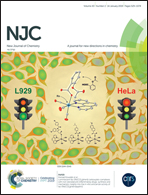Luminescent fac-[Re(CO)3(phen)] carboxylato complexes with non-steroidal anti-inflammatory drugs: synthesis and mechanistic insights into the in vitro anticancer activity of fac-[Re(CO)3(phen)(aspirin)]†
Abstract
Four fac-[Re(CO)3(phen)(L)] complexes with phen = 1,10-phenanthroline and L = a non-steroidal anti-inflammatory drug (NSAID) carboxylate ligand were obtained from the reaction of fac-[ReCl(CO)3(phen)] with ligands such as aspirin, (S)-(+)-ibuprofen, (S)-(+)-naproxen and indomethacin. Single-crystal X-ray diffraction analysis revealed a pseudo-octahedral coordination of the rhenium atom whereas the NSAID carboxylates act as monodentate ligands. The complexes show orange luminescence in polar solvents. Of the four compounds obtained, only fac-[Re(CO)3(phen)(aspirin)] exhibited activity against HeLa human cancer cells while it was inactive against the non-tumorigenic mouse L929 cell line. After uptake and dissociation in HeLa cells, the fac-[Re(CO)3(phen)(aspirin)] complex produces the luminescent fac-[Re(CO)3(phen)]+ cation, which predominantly accumulates in the mitochondria but does not penetrate to the nucleus, as shown by confocal microscopy. Once generated, the fac-[Re(CO)3(phen)]+ cation reversibly binds to hen egg white lysozyme (HEWL) while the aspirin ligand holds the ability to inhibit the COX-2 enzyme. The anticancer activity of the fac-[Re(CO)3(phen)(aspirin)] complex could be linked to ROS production, and cell cycle disturbance followed by triggering an apoptotic pathway of cell death.
![Graphical abstract: Luminescent fac-[Re(CO)3(phen)] carboxylato complexes with non-steroidal anti-inflammatory drugs: synthesis and mechanistic insights into the in vitro anticancer activity of fac-[Re(CO)3(phen)(aspirin)]](/en/Image/Get?imageInfo.ImageType=GA&imageInfo.ImageIdentifier.ManuscriptID=C8NJ05494K&imageInfo.ImageIdentifier.Year=2019)


 Please wait while we load your content...
Please wait while we load your content...